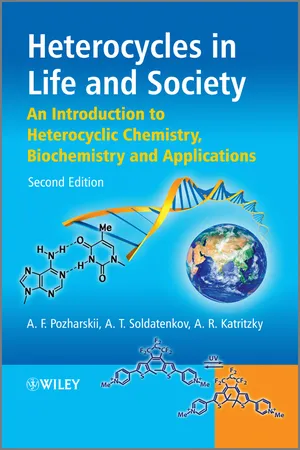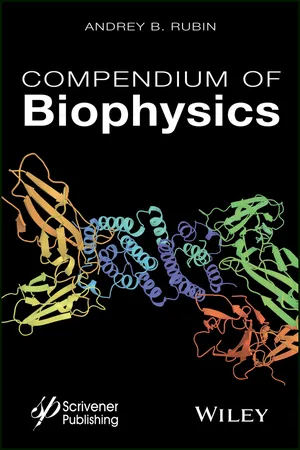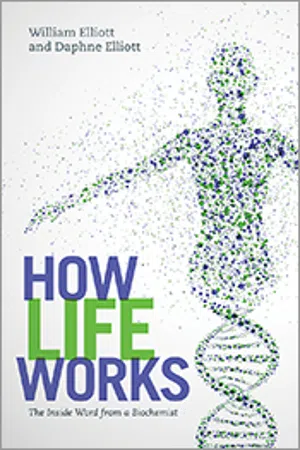Biological Sciences
ATP Hydrolysis
ATP hydrolysis is the process of breaking down adenosine triphosphate (ATP) into adenosine diphosphate (ADP) and inorganic phosphate (Pi), releasing energy in the process. This energy is used to drive various cellular processes, such as muscle contraction, active transport of molecules across cell membranes, and chemical synthesis. ATP hydrolysis is a fundamental mechanism for energy transfer in living organisms.
Written by Perlego with AI-assistance
Related key terms
4 Key excerpts on "ATP Hydrolysis"
- eBook - ePub
Heterocycles in Life and Society
An Introduction to Heterocyclic Chemistry, Biochemistry and Applications
- Alexander F. Pozharskii, Anatoly T. Soldatenkov, Alan R. Katritzky(Authors)
- 2011(Publication Date)
- Wiley(Publisher)
−1 . Thus, units of energy of the same order of magnitude need to be available.The main molecular carrier of energy, the unit of the biological ‘energy coinage’, is the tetraanion of adenosine triphosphoric acid, namely adenosine triphosphate (ATP; at physiological pH, the acidic protons of adenosine triphosphoric acid are almost completely ionized). The mode of action of ATP is based on the hydrolytic elimination of one of the two terminal phosphate groups to form adenosine diphosphate (ADP) or both to form adenosine monophosphate (AMP; Figure 5.1 ). These processes each release approximately 9 kcal mol−1 of energy.Figure 5.1 Hydrolytic cleavage of the phosphate groups of ATP with the formation of ADP and AMP.In some biochemical reactions, energy transfer is carried out by guanosine triphosphate (GTP), uridine triphosphate (UTP) or cytidine triphosphate (CTP). Though there is no evidence yet for the direct participation of the heterocyclic moieties of any of these compounds in the energy transfer, the presence of a purine unit in ATP suggests some function: the heterocyclic bases probably bind the ATP, GTP, UTP and CTP molecules (by noncovalent interactions) to the enzymes which transport them.A number of effects facilitate the liberation of energy by hydrolysis of the pyrophosphate bonds in ATP. First, hydrolysis provides additional negatively charged oxygen atoms. As a result, the products forming on cleavage of ATP are more effectively solvated than ATP itself.2 In other words, the strength of the bonds between phosphate residues in ATP together with the ‘hydration bonds’ between ATP and water are less than the strength of the ‘hydration bonds’ between ADP + phosphate and water.Second, the negatively charged oxygen atoms in ATP mutually repel each other; and when the length of the pyrophosphate chain decreases, the repulsion between the remaining oxygen atoms becomes less pronounced. Moreover, ATP Hydrolysis increases the possibility of resonance stabilization in the resulting adenosine diphosphate and phosphate anion compared with the initial molecule of ATP. Overlapping of the unshared electron pairs of such oxygen atoms with the vacant 3d - eBook - ePub
- David A Bender, Shauna M C Cunningham(Authors)
- 2021(Publication Date)
- CRC Press(Publisher)
chapter threeThe Role of ATP in Metabolism
Adenosine triphosphate (ATP) acts as the central link between energy-yielding metabolic pathways and energy expenditure in physical and chemical work. The oxidation of metabolic fuels is linked to the phosphorylation of adenosine diphosphate (ADP) to ATP, while the expenditure of metabolic energy for the synthesis of body constituents, transport of compounds across cell membranes and the contraction of muscle results in the hydrolysis of ATP to yield ADP and phosphate ions. The total body content of ATP + ADP is under 350 mmol (about 10 g), but the amount of ATP synthesized and used each day is about 100 mol (about 70 kg), an amount equal to body weight.Objectives
After reading this chapter, you should be able to:• explain how endothermic reactions can be linked to the overall hydrolysis of ATP → ADP and phosphate• describe how compounds can be transported across cell membranes against a concentration gradient and explain the roles of ATP and proton gradients in active transport• describe the role of ATP in muscle contraction and the role of creatine phosphate as a phosphagen• describe the structure and functions of the mitochondrion and explain the processes involved in the mitochondrial electron transport chain and oxidative phosphorylation, explain how substrate oxidation is regulated by the availability of ADP, and how respiratory poisons and uncouplers act.3.1 Adenine NucleotidesNucleotides consist of a purine or pyrimidine base linked to the 5-carbon sugar ribose. The base plus sugar is a nucleoside; in a nucleotide the sugar is phosphorylated. Nucleotides may be mono-, di- or triphosphates.Figure 3.1 The adenine nucleotides (the box shows the structures of adenine, guanine and uracil; guanine and uracil form a similar series of nucleotides).Figure 3.1 shows the nucleotides formed from the purine adenine – the adenine nucleotides, adenosine monophosphate (AMP), ADP and ATP. Similar families of nucleotides that are important in metabolism are formed from the guanine and uracil bases (see also Section 10.3.2 for a discussion of the role of cyclic AMP in metabolic regulation and hormone action, and Section 10.3.1 - eBook - ePub
- Andrey B. Rubin(Author)
- 2017(Publication Date)
- Wiley-Scrivener(Publisher)
At constant temperature, the change in the internal energy of the muscle is conditioned mainly by the change in the concentrations of different substances. As demonstrated by V. A. Engelgardt and M. N. Lyubimova (1939), interaction of actin with myosin underlying muscle contraction, is accompanied by hydrolysis of adenosine-triphosphate (ATP). Therefore, it was natural to suggest that just this reaction determines the rate of changes in the internal energy of the muscle upon its contraction.At physiological concentrations of ATP, ADP and PI in a muscle, the free energy of hydrolysis of one ATP molecule is about (8 ÷ 10)10–20 J which makes 48–60 kJ/mol. At physiological temperature, heat energy kB T, where T is the absolute temperature and kB is the Boltzmann constant, is about 4 · 10–21 J. Accordingly, the free energy of ATP Hydrolysis is 20–25kB T. Remember that we should distinguish the standard free energy of ATP Hydrolysis, , determined under standard conditions (the pressure of 1 atm, temperature of 25 °C, and 1 mol/l ATP, ADP and phosphate concentrations), and the real free energy determined at those concentrations of ATP, ADP and inorganic phosphate PI which are in the muscle at the given instant of time. The standard free energy of hydrolysis, , is about –30 kJ/mol, while the real free energy is determined from the relation(22.5)where [ATP], [ADP] and [PI ] are concentrations of the corresponding substances in mol/l, R is the universal gas constant, and T is the absolute temperature. Concentrations of ATP, ADP and phosphate in muscles are approximately 5 · 10–3 M, 5 · 10–4 M and 10–3 M, respectively; when substituted in the relation for the free energy, this gives 50–60 kJ/mol.Structure of Muscle Cells. A muscle fiber is a complicated multinuclear cell containing thousands of thinner elongated formations — myofibrils — of 1–2 µm in diameter, which stretch from one end of the fiber to the other. A microfibril consists of elementary contractile units — sarcomeres (Fig. 22.3 ).Figure 22.3. - eBook - ePub
How Life Works
The Inside Word from a Biochemist
- Daphne Elliott, William Elliott(Authors)
- 2015(Publication Date)
- CSIRO PUBLISHING(Publisher)
The importance of this chemical strategy of incorporating the energy of ATP into energy-requiring chemical reactions cannot be overstated. It might be described as one of the secrets of life. It applies to virtually everything in the body. There are hundreds of different enzymes transferring −P* groups to different molecules. As one example, when you raise your arm −P* groups are transferred from ATP molecules to your muscle proteins where they are then released as −Pi. This supplies the energy for the muscle to contract. The mitochondrial furnaces then immediately spring into action and convert the ADP + −Pi back to ATP again.Box 2.3: How ATP drives energy-requiring reactionsAn enzyme transfers a −P* group from ATP to A to give A−P*. A second enzyme now reacts with A−P* and adds B to A, displacing −P* which is released as −Pi (which has zero energy). We can summarise all this very simply as follows:1st step: A + ATP → A−P* + ADP (ADP, adenosine diphosphate, is ATP which has lost one phosphate).2nd step: A−P* + B → A−B + PiIf you put these two reactions together as a summary of the whole process (and it is the whole process which counts so far as the second law is concerned) we get:Overall: A + B + ATP → A−B + ADP + PiThe energy supplied by ATP breakdown is 30 kJ but only 13 kJ is needed to join A and B together, so the overall process is 17 kJ downhill and will proceed to completion. It is completely in accord with the second law. For some chemical syntheses even more energy is needed, and for these a simple modification is used in the chemical reaction so that two high-energy phosphates are split off the ATP, giving a big energetic kick to the reaction.The magnificent concept of life running on high-energy phosphate groups of ATP was put forward in 1941 by Fritz Lipmann working in a laboratory of the Massachusetts General Hospital in Boston, which is part of the Harvard Medical School. Lipmann illustrated his concept as a rotating dynamo with ADP and Pi going in and ATP coming out, the dynamo being driven by food oxidation. It accurately outlined the pattern of energy utilisation of all life forms and his concepts are as true today as they were 50 years ago.Lipmann was the archetype of a brilliant scientist totally absorbed in his work. He had an unworldly air, and was liked by all who knew him. When Bill was a member of Lipmann’s laboratory he took lessons at a local driving school and obtained a licence. Lipmann, who had always wanted to learn to drive a car, was very impressed by this and asked him for the phone number of the school. His protective second-in-command, Dave Novelli, quietly said to Bill, ‘For God’s sake don’t give it to him, he’ll kill himself.’ Bill managed to avoid doing so. Lipmann never got a driving licence, but in 1953 he did get a Nobel Prize. His phosphate bond energy concept had, and still has, a tremendous influence on research into the biochemistry of life.
Learn about this page
Index pages curate the most relevant extracts from our library of academic textbooks. They’ve been created using an in-house natural language model (NLM), each adding context and meaning to key research topics.



